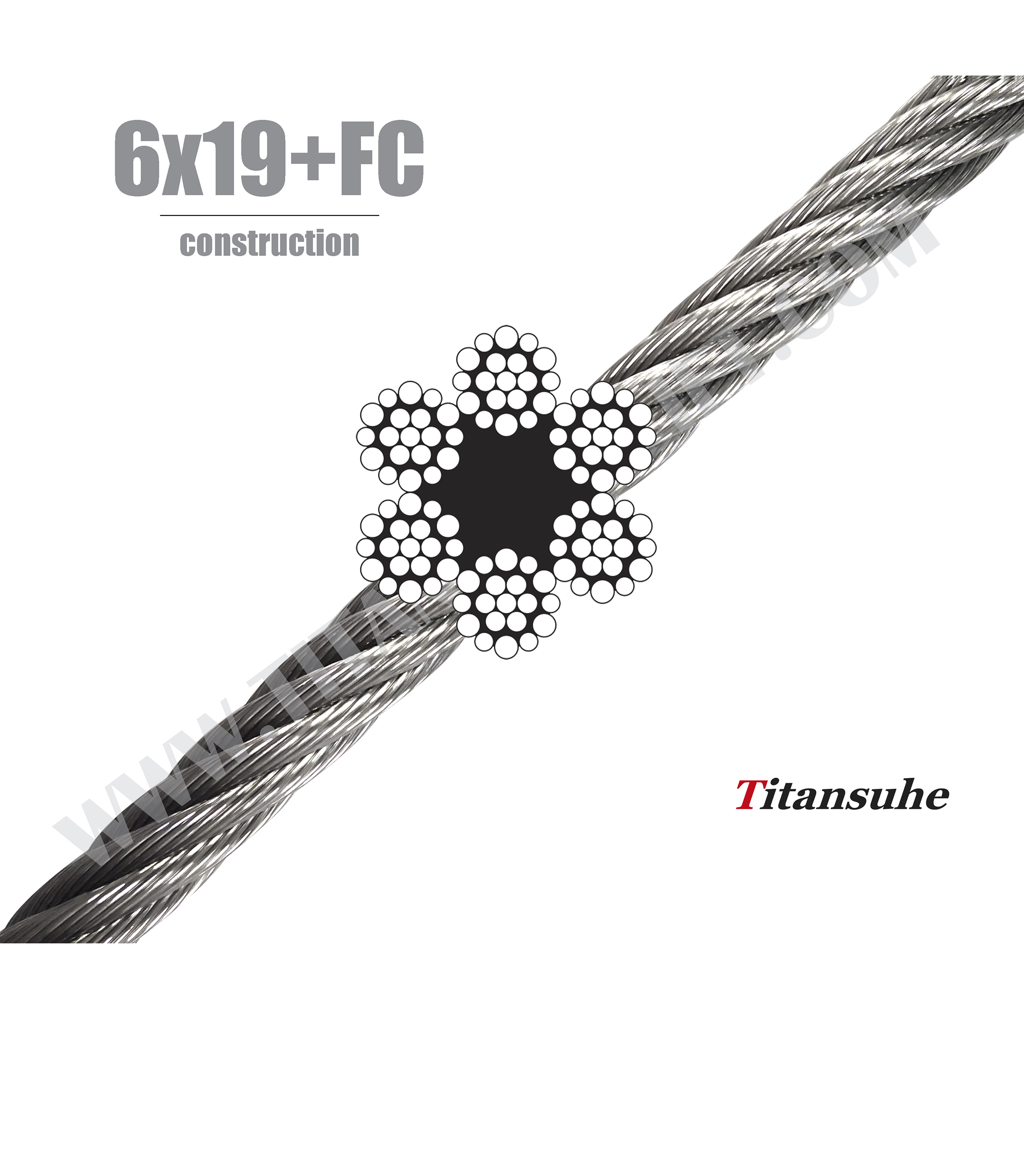Types of Steel Wire Rope
Categories of TITANSUHE's steel wire ropes
Elevator wire ropes
6x19S+FC,6x19W+FC,6x25F+FC,6x29F+FC,6x36WS+FC,8x19S+FC,8x19W+FC,8x25F+FC,8x19S+IWRC,8x19W+IWRC,8x25F+IWRC,8x19S+IWRF,8x19W+IWRF,8x25F+IWRF,8x19S+IWRF
General Engineering Wire Ropes
6x19+FC, 6x19+IWS or IWR, 6x37+FC, 6x37+IWR or IWS, 6x61+FC, 6x61+IWR, 8x61+FC, 8x61+IWR, 18x7+FC, 18x7+IWS, 34x7+FC, 35x7
Fish Wire Ropes
6x12+7FC, 6x24+7FC
Aircraft Cables
7x7,7x19
Stainless Steel Wire Ropes
6x7+FC, 7x7, 7x19, 6x19+FC, 6x36+IWRC
What is Tensile Grade of Steel Wire Ropes?
The tensile grade of a wire rope refers to the strength of its constituent wires. For general engineering wire ropes, there is only single tensile grade, normally comes as 1570n/mm2, 1670n/mm2, 1770n/mm2, 1870n/mm2, 1960n/mm2 and 2160n/mm2. For elevator wire ropes, they have dual tensile strength and outer wires is lower tensile strength, inner wires is higher tensile strength, for example 1180/1770n/mm2 or 1370/1770n/mm2.
What Kind of Wire Ropes are Used for Elevator?
The most used wire ropes for elevator are 6 strands or 8 strands wire rope constructed with Seale strand, Warrington Strand or Filler Wire Strand.
Seale strand has larger diameter of wires on the outer layer and has smaller wires on the inner layer. The larger wires has better abrasion resistance, while the smaller wires offer better flexibility.
Warrington has an alternative arrangement of smaller and larger wires on the outer layer to get a combination of flexibility and abrasive properties.
Filler Wire has smaller wires filling the empty spaces between outer and inner layer. This kind of strand provides better fatigue resistance and good abrasive properties.
How to order Steel Wire Ropes
To get proper steel wire ropes, you need to provide below general information:
Construction of wire rope: How many strands in total and how many wires in each strand. The inside core is fiber or steel wire.
Diameter of wire rope: in millimeter or inch
Tensile Strength: 1570n/mm2, 1670n/mm2, 1770n/mm2, 1870n/mm2, 1960n/mm2 and 2160n/mm2. Different tensile strength decide the final breaking strength
Surface treatment: Self color (ungalvanized), electric galvanization, hot dip galvanization, PVC coating or others
Packing Length: How many meters/inches per reel or per coil
Following information will be necessary if you use steel wire rope for particular project
1. Lay selection: there are right regular lay, left regular lay, right lang lay and left lang lay
Lubrication: what kind of lubrication is required, such us less oil if you want a clean operation or heavy grease for the applications that have much frictions.
Certificate: Mill test certificate or a third party inspection certificate needed
If you are not clear for all above, you can just advise us what purpose you will use the wire rope for, our professional engineering team will give you proposal and technical details
Tips of Safe Use Steel Wire Ropes
Care must be taken during rope installation since the rope is not supported when it is unrolled from the reel, until it is properly installed.
Care must be taken to unroll and not laterally pull wire rope when pulling it off the reel. Be careful not to get any loops.
Wire rope cutting: Both sides of cutting point apart 10-20mm using iron wire to tie up, the tie length is 2-4 times of rope diameter. Use proper tools to cut wire ropes. If such tools are not available and a cutting torch must be used, prevent short circuit occurring between the torch tip and the wire rope. When welding job is performed in the elevator shaft, prevent any debris getting on the wire rope and causes damage.
If the wire rope is not straight right off the reel, apply tension to the rope and fix it to proper form.
Do not drag ropes over sharp edges, and prevent any dirt and debris sticking on the rope. This will cause damage to the traction groove and rope itself.
Ropes must be prevented from rotating during installation since free-hanging ropes will untwist under their own weight.
Check the rope tension after mounting with a suitable device. Make sure all ropes in the same group are evenly tensioned.
How to Select Elevator Wire Rope
Class and type of core | Construction | Application | Remarks |
6x19+FC | 6x19S+SFC 6x19W+SFC 6x25F+SFC | Governor ropes | Recommendation: NFC for suspension ropes SFC for governor ropes |
6x19S+NFC 6x19W+NFC 6x25F+NFC | Suspension ropes for low-rise low-speed elevators |
8x19+FC | 8x19S+SFC 8x19W+SFC 8x25F+SFC | Governor ropes |
8x19S+NFC 8x19W+NFC 8x25F+NFC | Suspension ropes for elevator speed <=2m/s, building height <=60m | Please specify when ordering such ropes |
8x19S+GSF 8x19W+GSF 8x25F+GSF | Suspension ropes for elevator speed >2m/s and <=2.5m/s, building height <=60m |
8x19 Steel Core and Mixed Core | 8x19S+IWRC 8x19W+IWRC 8x25F+IWRC | Suspension ropes for elevator speed <4m/s,building height <=100m | A technical agreement needs to be signed for ordering these ropes. Products comply to: Q/320205KABW02-2009 |
8x19S+IWRF 8x19W+IWRF 8x25F+IWRF | Suspension ropes for elevator speed <4m/s,building height <=100m |
9x19 steel core and mixed core | 9x17S+IWRC 9x19S+IWRC 9x19W+IWRC 9x21F+IWRC 9x25F+IWRC | Suspension ropes for elevator speed >4m/s,building height >100m |
9x17S+IWRF 9x19S+IWRF 9x19W+IWRF 9x21F+IWRF 9x25F+IWRF |
6x36+FC | 6x29F+FC 6x36WS+FC | Compensation ropes |

















































